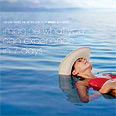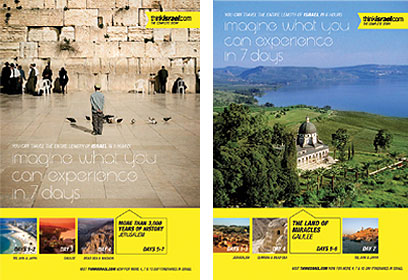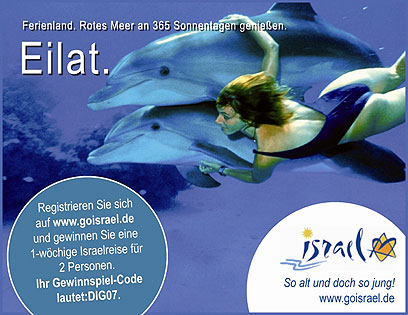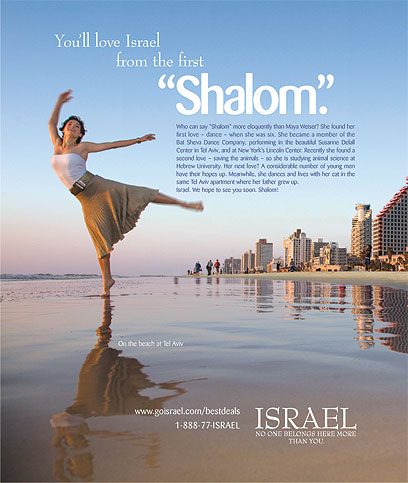
Putting Israel on the map
It's not easy taking a country which appears on the news worldwide in negative contexts and turning it into an attractive tourist destination, but this is exactly what the Israeli Tourism Ministry is attempting to do. Here is a peek behind the scenes of the campaigns marketing Israel across the world
"It takes six hours to cross Israel. Imagine what you can experience in seven days," the ad says.
At the bottom you see details of what such a trip would include: Three days in Tel Aviv and Jaffa, one day in Jerusalem, one day in the Sea of Galilee and two days in "the lowest point on earth – the Dead Sea."
Tourism Ministry officials hope that these ads will cause millions of Americans, Britons, Germans, French and Russians to seriously consider visiting Israel. Marketing such a country, which stars on foreign news mainly in negative contexts, is quite a big challenge. In the past, images of Eilat's sun and beaches were enough to attract masses of pale tourists, but today the audience is more sophisticated – as is the marketing.
Israel as a product
Oren Drori, the Tourism Ministry's senior deputy director-general and head of marketing, says that first of all one must understand that the ministry's defined goal is to bring tourists into the State of Israel for economic reasons.
It is enough to say that the output from incoming tourism in 2007 was estimated at NIS 12.5 billion (about $3.46 billion). That year, 2.3 million tourists visited Israel – 25% more than in 2006 and a rise of 20% compared to 2007. The target for 2012 is at least 5 million tourists in one year. How does one do that? Again, marketing is the key word.
"The Tourism Ministry is no different than any marketing company marketing a product," Drori explains, "although our product is slightly more complicated in terms of the product and the target audiences."
The Tourism Ministry takes its work seriously.
"Our job is scientifically backed up. It is based on market research and scientific analysis and mapping work conducted by external elements – research companies, advertising and public relations firms, etc. In most cases, the companies are local, as they have an advantage of being familiar with the local market."
With the product being tourism in Israel, the first stage is to define the audience. The Tourism Ministry's budgets are limited, and therefore it works from a defined strategy of priorities according to target audiences, according to countries and inside the countries. The first stage is to select the target countries.
"We focus on countries from where there is actual traffic and potential traffic, and in which there are audiences which we know – based on studies – are likely to consume us," Drori says.

Connecting between people and the land. From the American campaign
So where do most tourists to Israel come from? As always, the US took the first place in 2007 as the origin country for tourism to Israel, with 580,000 visitors (a quarter of the overall number of tourists). France came in second with 245,000 visitors, followed by Russia (200,000), England (170,000) and Germany (100,000).
It's no wonder, therefore, that these are the countries which lead the list of states in which Israel invests in self-advertising.
Drori notes that Russia is a developing market, where "we have every reason not to stay behind and rather be the ones to ride this wave." The tourism traffic is also on the rise from Poland, Ukraine and eastern Asia countries.
The second stage is identifying the specific target audiences in each country. The target audience is examined from the aspect of age, religion, socioeconomic situation, etc. – and defining the social groups the designated campaign is aimed at appealing to – for example, certain religious communities.
"We build a campaign according to each group, based on the question which product components work best for this group. In each group we emphasize different product components in a different manner, and try to activate different motivations," Drori explains.
"After preparing a certain advertising activity, we make sure that we are using the right message and the right tools to target the right audience. We examine this through focus groups and surveys. The entire campaign will only be launched after we confirm the assumptions – or after amendments made in accordance with the results of the different tests."
One of Israel's most important target audiences is religious Christians in the US. Drori uses this audience as an example for the great difference between the target audiences.
"Even in a group which is seemingly homogenous like the Christians, the basic approach differs among the various churches. For example, the Catholics are interested in historic sites where historic events actually took place, and they view them as holy sites – the Church of the Holy Sepulcher in Jerusalem, the Mount of Precipitation (Mount of the Leap) in the Nazareth area or the baptism area.
"The Protestants, on the other hand, are more interested in the Holy Ghost in general and less in a specific site. They, for example, prefer the Garden Tomb in Jerusalem and also want to see Jewish sites, like the Western Wall. If you take a look at the brochures we hand out to the two groups, you will discover that they are completely different, both in terms of the featured sites and in terms of the emotions we appeal to."
_wa.jpg) Creating a feeling of a pleasant welcome. From the American campaign
Creating a feeling of a pleasant welcome. From the American campaign
Tel Aviv or Eilat?
But despite the many differences between different and diverse target audiences, in most cases the Tourism Ministry has no option to invest in advertising targeting a focused audience segment.
In such cases, Drori says, "We work on our basic marketing circles, the 'bread and butter,' and these are the religious communities and tourism professionals."
Most of the advertising takes place in professional newspapers and designated magazines. So what are the things which sell Israel to the most general public?
It turns out that Israel has a number of anchors which are used in almost every advertising campaign. The first is of course Jerusalem and the holy Christian sites in the Galilee and Lake Kinneret. A second key anchor is the Dead Sea, which is a popular target among dermatitis patients and other patients arriving for medical reasons, but current ads promote the site making use of the growing interest in "well being tourism" – a combination of health and pampering.
But there are more complex cases, and Eilat is a good example. The southern city is still considered a resort site in the eyes of the Western European, Northern European and Russian public, but it is safe to assume that you will not see the resort town starring in ads in the United States. While the European tourist can be attracted with some sea, sand and sun, for the American tourist this is not a good enough reason to take such a long flight.
Tel Aviv is an example of a relatively new anchor, and it is definitely getting more and more volume in Israel's ads.
"Tel Aviv is accelerating as an additional product, which suggests spending two or three days in a destination which provides 1,001 aspects of day life and nightlife," says Drori. "Architecture, culture, and especially a milieu and wandering the streets, similar to the growing interest in Barcelona, which has not been a classic European tourist destination."
Here, once again, the campaign mostly targets the European audience rather than the American one.
Want to see how it works in practice? Here are some examples of the Tourism Ministry's current campaigns in the selected countries.
Britain
The Britain campaign includes a series of ads, each emphasizing a different aspect of Israel, but all offering a one-week tour of the country. The idea is to sell the notion that in Israel one can see a lot in very little time. Two of the ads featured here turn to the religious public (the Galilee for the Christians and the Western Wall for the Jews) and two appeal to the more hedonistic audience. One is devoted to the Dead Sea and the other to the Tel Aviv beach.

Germany
Ads presenting classic destinations like Eilat and the Dead Sea, alongside an ad presenting the Galilee as a destination for an adventurous family trip.


Russia
Among the Russian public, Israel is marketed through its familiar anchors: Eilat, the Dead Sea and Jerusalem.
"The destinations are accompanied by personal stories of Western tourists, because we have discovered that the Russian tourist seeks to imitate the Western tourist," says Drori.

France
The France campaign is a good example of the increasing "cultural tourism" phenomenon – no more sunbathing vacation in an isolated destination, but touring a relatively wide geographical area and consuming culture in its wide meaning – religion, history and archaeology, as well as shopping, local culinary and music.

United States
The US is a special case in the history of the Tourism Ministry's marketing of Israel. This is an unprecedented campaign in terms of its size and the amounts of money invested in it.
"The campaign was first launched in the middle of 2007, with the clear knowledge that we will not see demand before the beginning of 2008," says Drori. "This campaign included an expenditure of some $12 million a year only on advertising activities."
The campaign is based on two major channels: The Christian channel and the general channel.
The campaign aimed at attracting Christians makes use of a unique series of messages based on the slogan, "Visit Israel. You'll never be the same." The goal is to work on people's emotions while using images and "testimonies" of first-class religious leaders recruited to the campaign.
The second channel is more special. "This is the first time we create a campaign for the broad public," Drori explains. "We are not perceived as a regular tourism product by American citizens, and therefore we must change Israel's image and turn it into a real target."
There is still an appeal to a certain segment, and in this case it is the relatively sophisticated tourist. The advertising therefore focuses on geographical areas – New York and its surroundings, southern Florida, Miami, Los Angeles and California – which are identified with large populations belonging to a relatively high socioeconomic and who have habits of traveling overseas.
The motto accompanying the campaign is "You'll love Israel from the first 'shalom'."
Drori explains, "We were looking for an icon. If the French have the Eiffel Tower, we have the 'shalom.' True, it's not visual, but it's extremely well-known and very positive – it is portrayed as Hawaii's 'aloha.'
"In addition, we were looking to create a connection between people and the landscape, between people and the land. That's why we used real people rather than models, and attached their personal, human story to the pictures, in order to stir emotions."











